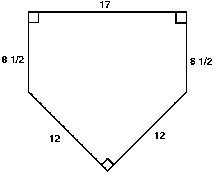In many ways, baseball is a numbers game: Strikeouts, home runs, batting averages, innings pitched, complete games, runs batted in, earned run averages, and players left on base in scoring position in the bottom of the ninth inning when a left-handed batter flies out. It’s also a game played on a field of considerable geometric regularity. The baseball “diamond,” for instance, is properly a square, 30 yards on each side.

Several years ago, as an assistant coach for his son’s baseball team, mathematician Michael J. Bradley of Merrimack College in North Andover, Mass., spent some time familiarizing himself with the official league rules. He came upon the following passage and accompanying diagram.
Home base shall be marked by a five-sided slab of whitened rubber. It shall be a 12-inch square with two of the corners filled in so that one edge is 17 inches long, two are 8 1/2 inches and two are 12 inches.
Something about these numbers puzzled Bradley. “Wait a minute,” he thought. “That 17 should be 12 times the square root of 2. It can’t be an integer. It has to be an irrational number.”
Indeed, the diagram implies the existence of a right triangle with sides 12, 12, and 17, and that’s not quite a Pythagorean triple: 122 + 122 = 288 and 172 = 289.
At first, the discrepancy bothered Bradley. The dimensions of home plate aren’t mathematically correct, he thought. But baseball, like engineering and science, is a game of inches and feet. To the degree of accuracy required to construct a workable home plate, 17 is as good as (and certainly more measurable than) the more exact value of 12 times the square root of 2.
“I soon realized that the problem did not reside in the realm of pure mathematics where I usually live, but rather in the world of applied mathematics where my engineer and scientist colleagues practice their professions,” Bradley noted. There’s a crucial difference between measured numbers (accurate to a certain number of significant digits) and purely mathematical numbers.
Bradley’s observations made me curious about the history of the dimensions that now define the game. The playing field has been the same shape and size since the rules of baseball were first published more than 140 years ago. The size, placement, and shape of the bases, however, have changed over the years.
Initially, the rules insisted that bases be 1 square foot in area (most simply, a 1 foot by 1 foot square). Out on the field, the center of each base sat directly over a corner of the infield square. Home plate started as a circular iron plate, painted white, with a diameter not less than 9 inches. By the 1870s, however, home plate had become a square just like the other bases.
In 1877, the width of the bases was increased to 15 inches but home plate stayed at 12 inches. First and third base were moved to their present positions, where they fit snugly inside the corners of the square that defines the infield.
This change was made so that umpires could call foul balls more easily. Second base, however, still stuck out of the square, where it remains to this day.
The year 1900 saw the introduction of the five-sided home plate, with a flat side rather than a point facing the pitcher. The extra rubber made it easier for both umpires and pitchers to judge when a ball “cut the corner,” especially when dirt happened to cover the corners of home plate.
That’s it for the numbers. It’s time to play ball!






